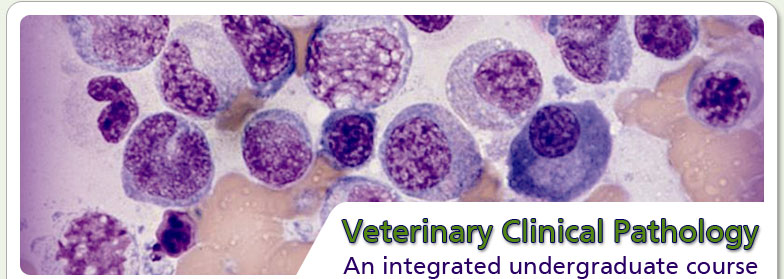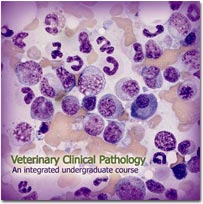GENERAL CLINICAL PATHOLOGY
LECTURE 1: DEFINITION AND GENERAL CONCEPTS OF VETERINARY CLINICAL
PATHOLOGY. FACTORS INFLUENCING LABORATORY RESULTS: Biological and analytical factors (pre-instrumental, instrumental, post-instrumental).
LECTURE 2 : CLINICAL APPLICATION OF TESTS RESULTS. Reference Values. Units of Measurement. Validation of Tests for Clinical Use.
LECTURE 3: EQUIPMENT FOR VETERINARY PRACTICE LABORATORIES.
Setting up a practice laboratory. Basic equipment. Mid-range equipment. Advanced equipment for referral laboratories.
HAEMATOLOGY
LECTURE 4. TESTS IN HAEMATOLOGY: THE HAEMOGRAM. Packed cell volume (PCV)/haematocrit (Hct) and total proteins. Erythrocyte (RBC) count, Haemoglobin and indices. Leukocyte total and differential count. Platelet count, morphology and Mean Platelet Volume (MPV).Histograms. Blood smear evaluation
LECTURE 5. EVALUATION OF BLOOD SMEAR RBCs AND RETICULOCYTES. RBC morphological evaluation. Reticulocyte count and evaluation
LECTURE 6. ERYTHROCYTE DISORDERS. Polycythemias (erythrocytosis) and different types of anaemias.
LECTURE 7. LEUKOCYTES. Types of leukocytes: functions and interpretation of changes in blood values. Morphological changes. General patterns of WBC disorders.
LECTURE 8. HAEMOSTASIS. Normal haemostasis. Clinical signs of haemostatic disorders. Sample collection and storage. Laboratory evaluation of haemostasis. Haemostatic disorders.
LECTURE 9. BONE MARROW: COLLECTION AND INTERPRETATION. Indications and contraindications. Collection. Evaluation of cell lines: Erythropoiesis, Megakaryopoiesis, Myelopoiesis.
LECTURE 10. BLOOD GROUPS AND TRANSFUSIONS. Blood Group Systems. Blood group testing and cross-matching. Definition, aims and indications for blood transfusion.
CLINICAL BIOCHEMISTRY
LECTURE 11. GLUCOSE. Physiological characteristics and measurement. Abnormalities.
LECTURE 12. LIPIDS AND KETONE BODIES. Lipids: Physiological characteristics and abnormalities. Ketone bodies: types and causes of increase.
LECTURE 13. PROTEINS. Physiological characteristics. Measurement: serum protein and electrophoresis. Serum protein abnormalities. Fibrinogen
LECTURE 14. LIVER. Tests for detecting hepatocellular injury, cholestasis and hepatic dysfunction
LECTURE 15. EXOCRINE PANCREAS AND GASTROINTESTINAL TRACT.
LECTURE 16. URINARY SYSTEM. Urinalysis. Serum/plasma Urea and Creatinine concentration. Urine protein to creatinine ratio.
LECTURE 17. MUSCLES. Tests for detecting: myocyte injury and myocyte activity
LECTURE 18. ENDOCRINE TESTS. Thyroid. Adrenocortical. Other hormones: parathyroid, insulin, growth hormone, progesterone, relaxin.
LECTURE 19. ELECTROLYTES AND ACID/BASE ASSESSMENT. Body fluid compartments, sodium, potassium and chloride abnormalities; basis for acid/base evaluation
LECTURE 20. MINERALS. Major elements. Trace elements.
CYTOLOGY
LECTURE 21: INTRODUCTION TO CLINICAL CYTOLOGY. Specimens. Specimen handling. Advantages and limitations. CHARACTERISTICS OF SOME BENIGN LESIONS. Inflammation. Haematoma. Lipoma. Cyst. Sialocoele.
LECTURE 22. CYTOLOGY OF MASSES AND ORGANS. ANALYSIS OF BODY FLUIDS. Transudate. Modified transudate. Exudate. Neoplastic effusions. Others:haemoperitoneum, uroperitoneum, chylous effusion
LECTURE 23. CYTOLOGY OF NEOPLASTIC MASSES. Benign Neoplasms. Cytological criteria of malignancy. CYTOLOGY OF LYMPH NODES
LECTURE 24. CYTOLOGY OF CEREBROSPINAL FLUID (CSF), SYNOVIAL FLUID AND LAVAGES
APPENDIX: SAMPLING PROCEDURES |



